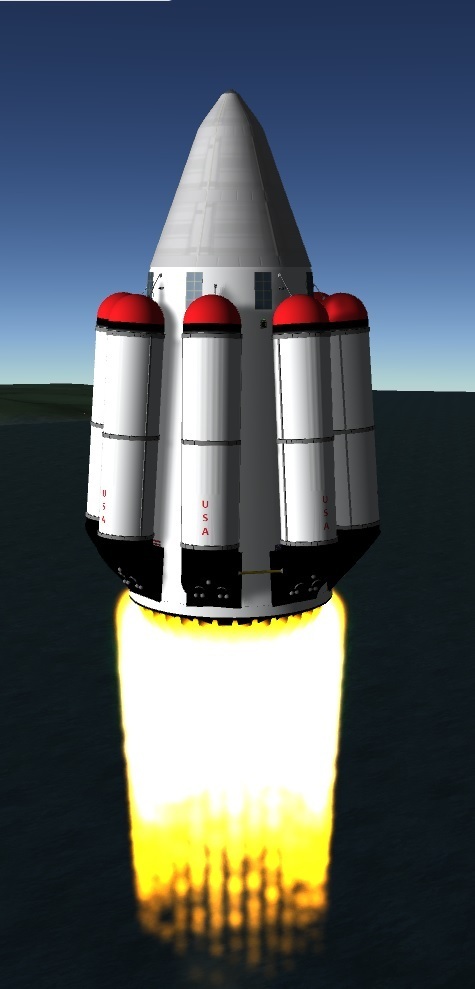License: MIT
Game Version: 1.12.5
Downloads: 1,391
(Developer's Note: This project is very much in active development so please leave your feedback on the forums thread!)
Inspired by the pioneering work of Philip Bono, the KROMBUS Project aims to bring the American SSTO VTOVL orbital launch vehicle study from 1964 to life in Kerbal Space Program.
Dependencies:





Here's a history from Astronautix:
"In 1964, Phil Bono of Douglas Aircraft Co. proposed a low-cost heavy lift VTVL SSTO RLV plus lunar base as a logical follow-on to the Apollo project. Bono's "Reusable Orbital Module-Booster & Utility Shuttle" (ROMBUS) concept was based on his patented plug nozzle rocket engine design, which doubles as a heat shield during atmospheric reentry. The vehicle's base-first reentry mode assures a stable condition during recovery since the mass of the engine is very high, i.e. far aft center of gravity. The plug nozzle would be cooled by circulating liquid hydrogen through the same regenerative system used for cooling the engines and base of the vehicle while the engines are operating during ascent. Mixture ratio of liquid oxygen to hydrogen was raised to 7:1 -- about as close as one can get to the stoichiometric value of 8:1 without running into combustion chamber cooling problems. During ascent, the plug nozzle provides automatic altitude compensation and therefore good performance at both sea level atmospheric pressure and in space. For final orbital insertion, 16 of the 36 engines would burn for 3 seconds to provide the required velocity. ROMBUS would typically spend 24 hours in orbit before the ground track passes close enough to the launch site for de-orbit. Parachutes and (beginning at 0.73km altitude-) retrorockets would be used to safely land the vehicle. The final touchdown burn would be provided by four engines running at 25% thrust for approximately twelve seconds.
 Rombus Staging (Credit: NASA)
Rombus Staging (Credit: NASA)
To reduce the size and weight of the vehicle, the hydrogen fuel was to be stored in eight external jettisonable tanks. The tanks were jettisoned and then recovered by parachute as they were depleted during ascent to orbit. The earlier fully reusable "ROOST" concept was thus rejected since it did not leave much margin for growth in vehicle structure mass.
 Rombus SSTO Launch Vehicle (Credit: © Mark Wade)
Rombus SSTO Launch Vehicle (Credit: © Mark Wade)
The total life cycle cost would have been $10 billion 1964 $'s over 10 years including $4.088 billion for the development program. Bono mentioned the following SSTO RLV-specific advantages : increased reliability since each vehicle has a history, reduced development cost & complexity vs. multi-stage vehicles, economies of scale possible since plug nozzle engine units & tanks could be mass produced. The estimated direct launch cost was $22.4 million (=$28/lb. to a 568km orbit at 1964 economic conditions) and the planned vehicle turnaround time about 76 days. Bono also mentioned a direct operations cost goal of $12/lb (5-6 reuses) - $5/lb (>20 reuses) for a vehicle payload capability of 450t by the year 1975. In comparison, the Saturn V was then expected to cost $150-250/lb. The vehicle would have used the same Kennedy Space Center facilities as the Saturn boosters, although a new launch pad would have been required."
Stats for The KROMBUS Project
Downloads over time
Downloads per version
New followers per day
Top Referrers
- spacedock.info
- forum.kerbalspaceprogram.com
- www.google.com
- sd-prod-live.52k.de
- sd1b.52k.de
- sd1a.52k.de
- yandex.ru
- github.com
- sd-prod-stage.52k.de
- duckduckgo.com
Export Raw Stats
Raw stats are from the beginning of time until now. Each follower and download entry represents one hour of data. Uneventful hours are omitted.